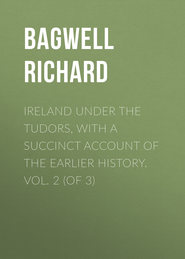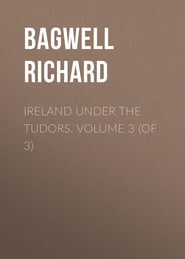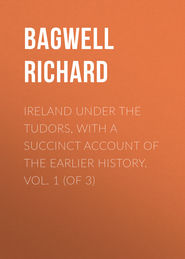По всем вопросам обращайтесь на: info@litportal.ru
(©) 2003-2024.
✖
Ireland under the Stuarts and during the Interregnum, Vol. I (of 3), 1603-1642
Настройки чтения
Размер шрифта
Высота строк
Поля
Chamberlain to Carleton, April 6, 1616, in Court and Times; Bacon to Sir George Villiers, July 1, 1616 (Spedding, v. 375). Installation of St. John in Liber Munerum, ii. 6. St. John to Winwood, August 1616 (No. 289); Lord Carew to Sir Thomas Roe (Camden Society) December.
138
Bacon to Sir George Villiers, July 5, 1616, in Spedding, v. 378; Davies to Lake, December 20, 1615; St. John to Winwood, December 31, 1616, and October 11, 1617; Licence to send agents, May 18, 1618; return of the Commissioners, 1618, No. 431; surrender of charter announced, August 4, 1619. Histories of Waterford by Smith and Ryland. Bacon had recommended procedure by Quo warranto or Scire facias, and St. John, doubtless prompted by Chief Justice Jones, says the same in his letter to the Privy Council, April 1618, No. 406.
139
Lord Deputy and Council to the Privy Council, August 4, 1619; St. John to the same, November 9; Corporation of Bristol to the same, January 31, 1620. There were no mayors or sheriffs of Waterford from 1618 to 1625, both inclusive.
140
Chichester to Salisbury, June 27, 1610. Report of Commissioners, November 12, 1613, p. 449. The latter is more fully given in Desiderata Curiosa Hibernica, ii. 372. In Chichester’s project (Irish Cal., 1614, No. 859) the escheated territory is described as ‘the Kinsellaghs, and Bracknagh, and McDamore’s country, McVadock’s country, the Murrowes, Kilhobuck, Farrenhamon and Kilcooleneleyer, and a small part of Farren Neale,’ to which Rothe adds ‘Clanhanrick.’ In 1606 the judges had declared that ‘Les terres de nature de gavelkind ne fueront partible enter les procheins heires males del cesty que morust seisie, mais enter touts les males de son sept.’ Davies’s Reports, 1628.
141
Report of Commissioners in 1613, ut sup.
142
Report of Commissioners in 1613, ut sup. Sir Henry Docwra’s letters of December 23, 1617, and March 3, 1618. Chichester’s original project and the English Council’s criticisms are calendared under 1612, Nos. 600-602.
143
Report of 1613 Commissioners ut sup.
144
Walsh’s petition followed by certificate, December 5, 1611; the King to Chichester, January 21 and March 22 and 31, 1612; Chichester to Salisbury, March 5. As to the intruding patentees see State Papers calendared under 1613, p. 452 sqq. A petition of Redmond MacDamore and others calendared under 1616, No. 248, is substantially the same as Walsh’s, and probably belongs to 1611. The sheriff gave possession to the patentees on May 7, 1613, forcing the doors where necessary and turning out the inmates.
145
The King to Chichester, April 16, 1613.
146
Rothe’s Analecta Sacra, iii. art. 19, Cologne, 1617. The text was evidently composed before Chichester had ceased to be viceroy, and therefore before the work of the Wexford settlement was quite finished.
147
St. John to the Privy Council, September 29, 1619, on which Gardiner mistakenly states that 300 outlaws were slain in connection with the Wexford plantation only. Same to same, November 9. Grant of 100l. to Hugh MacPhelim O’Byrne, ib. No. 602, and St. John’s letter to him, June 18, 1620; Sir Francis Blundell to the Council (written in London) July 20, 1620; Lord Deputy and Council to the Council, December 6, 1620 and May 25, 1621; Sir Thomas Dutton to Charles I., December 20, 1629; and Hadsor’s opinion calendared under 1632, 2190, 7. Donnell Spaniagh of Clonmullen and thirty-five other Kavanaghs, with many Wexford neighbours, were pardoned in 1602. Morrin’s Patent Rolls, Eliz. p. 607. Hadsor in Sloane MS. 4756.
148
The King to Chichester, April 12, 1615. Ely O’Carroll comprised the baronies of Clonlisk and Ballybritt, the southern portion of King’s County.
149
Certificate of survey, November 20, 1618; Lord Deputy and Council to the Privy Council, November 8, 1619; Commissions for settling the plantation, September 30, 1619 and April 10, 1620; Lords Justices and Council to the Privy Council, June 22, 1622; Lord Wilmot’s discourse, 1627, No. 534; Richard Hadsor’s propositions, 1632, No. 2190; Lords Justices to Vane, November 13, 1641.
150
Brief return of survey in Sloane MS. 4756.
151
St. John’s description of Connaught, 1614, in Carew, p. 295. St. John to Lords of Council, December 31, 1620, in Cal. of State Papers, Ireland; Sir Thomas Dutton to the King, December 20, 1629, ib.; Hadsor’s propositions, ib., 1632, p. 681. The final grant to Sir Frederick Hamilton is in Morrin’s Patent Rolls, Car. I. p. 541. In a letter to Wentworth of February 12, 1634-5, Viscount Wilmot suggests that Coote should be asked ‘what became of the 5,000l. allotted to be disbursed upon the town and wall of Jamestown,’ Melbourne Hall Papers, ii. 175.
152
St. John to the Privy Council, September 29, 1619; Privy Council to St. John, August 1621; extract of a letter calendared at June 17, 1624.
153
Sir John Digby to Buckingham, June 4, 1617, in Fortescue Papers (Camden Society); St. John to Buckingham, ib., November 24, 1618 and August 17, 1620; the King to St. John, concerning Sir Roger Jones, October 6, 1620. For the report as to disarming Protestants see Court and Times, ii. 304; communications between King and Privy Council calendared January 28 to February 3, 1622; St. John to the Privy Council, October 13, 1621 and April 8, 1622.
154
Court and Times, ii. 327; Ussher to Grandison, October 16, 1622, Works, xv. 180 and Hampton to Ussher, ib. 183; Cox’s Hibernia Anglicana, ii. 39.
155
Proclamation of January 21, 1623-4, Carew; Falkland to Calvert (with enclosures), October 20, 1623; to Conway (sent with Westmeath), April 27, 1624; Archbishop Abbot to Conway, September 10, 1623, Cal. of State Papers, Ireland, June 4, 1625.
156
Falkland to Conway, April 24, 1624; to Privy Council, March 16, 1625; Council of War for Ireland (Grandison, Carew, Chichester, etc.) to the Privy Council, July 6, 1624.
157
Lord Deputy to Lord Chancellor, October 22 and 28, 1624, and Loftus’s answer to the first; Conway to Grandison and others, November 24; Loftus to the Privy Council, January 10, 1625; Privy Council to the King, March 21.
158
For the wretched state of the army see State Papers, Ireland, passim, particularly the letters of Sir Richard Aldworth, October 17, 1626, and February 16, 1626.
159
Court and Times, of Charles I., July 11, 1628, i. 377. The King to Falkland, August 4 and 16, 1628.
160
Falkland to the Privy Council, May 3, 1623; Commissioners for Irish causes to same, July (No. 1058 in Cal.); Falkland to Buckingham, printed in Miss Hickson’s Ireland in the Seventeenth Century, i. 45. The latter is undated, but must be earlier than Middlesex’s fall in May 1624.
161
The evidence taken by Falkland is calendared at January 20, 1629. The evidence taken before the special commission is printed in Gilbert’s Confederation and War, i. 187. Particulars as to the lands may be found in Morrin’s Cal. of Patent Rolls, Car. I. pp. 356, 366, 399, 496. Accounts from various points of view are given in Gardiner’s History, viii. 20, in Miss Hickson’s Seventeenth Century, i. 38, and in Carte’s Ormonde, book i. Ussher admitted that the special commission had made more haste than good speed, see his letter of January 22, 1628-9, Works, xv. 421.
162
138
Bacon to Sir George Villiers, July 5, 1616, in Spedding, v. 378; Davies to Lake, December 20, 1615; St. John to Winwood, December 31, 1616, and October 11, 1617; Licence to send agents, May 18, 1618; return of the Commissioners, 1618, No. 431; surrender of charter announced, August 4, 1619. Histories of Waterford by Smith and Ryland. Bacon had recommended procedure by Quo warranto or Scire facias, and St. John, doubtless prompted by Chief Justice Jones, says the same in his letter to the Privy Council, April 1618, No. 406.
139
Lord Deputy and Council to the Privy Council, August 4, 1619; St. John to the same, November 9; Corporation of Bristol to the same, January 31, 1620. There were no mayors or sheriffs of Waterford from 1618 to 1625, both inclusive.
140
Chichester to Salisbury, June 27, 1610. Report of Commissioners, November 12, 1613, p. 449. The latter is more fully given in Desiderata Curiosa Hibernica, ii. 372. In Chichester’s project (Irish Cal., 1614, No. 859) the escheated territory is described as ‘the Kinsellaghs, and Bracknagh, and McDamore’s country, McVadock’s country, the Murrowes, Kilhobuck, Farrenhamon and Kilcooleneleyer, and a small part of Farren Neale,’ to which Rothe adds ‘Clanhanrick.’ In 1606 the judges had declared that ‘Les terres de nature de gavelkind ne fueront partible enter les procheins heires males del cesty que morust seisie, mais enter touts les males de son sept.’ Davies’s Reports, 1628.
141
Report of Commissioners in 1613, ut sup.
142
Report of Commissioners in 1613, ut sup. Sir Henry Docwra’s letters of December 23, 1617, and March 3, 1618. Chichester’s original project and the English Council’s criticisms are calendared under 1612, Nos. 600-602.
143
Report of 1613 Commissioners ut sup.
144
Walsh’s petition followed by certificate, December 5, 1611; the King to Chichester, January 21 and March 22 and 31, 1612; Chichester to Salisbury, March 5. As to the intruding patentees see State Papers calendared under 1613, p. 452 sqq. A petition of Redmond MacDamore and others calendared under 1616, No. 248, is substantially the same as Walsh’s, and probably belongs to 1611. The sheriff gave possession to the patentees on May 7, 1613, forcing the doors where necessary and turning out the inmates.
145
The King to Chichester, April 16, 1613.
146
Rothe’s Analecta Sacra, iii. art. 19, Cologne, 1617. The text was evidently composed before Chichester had ceased to be viceroy, and therefore before the work of the Wexford settlement was quite finished.
147
St. John to the Privy Council, September 29, 1619, on which Gardiner mistakenly states that 300 outlaws were slain in connection with the Wexford plantation only. Same to same, November 9. Grant of 100l. to Hugh MacPhelim O’Byrne, ib. No. 602, and St. John’s letter to him, June 18, 1620; Sir Francis Blundell to the Council (written in London) July 20, 1620; Lord Deputy and Council to the Council, December 6, 1620 and May 25, 1621; Sir Thomas Dutton to Charles I., December 20, 1629; and Hadsor’s opinion calendared under 1632, 2190, 7. Donnell Spaniagh of Clonmullen and thirty-five other Kavanaghs, with many Wexford neighbours, were pardoned in 1602. Morrin’s Patent Rolls, Eliz. p. 607. Hadsor in Sloane MS. 4756.
148
The King to Chichester, April 12, 1615. Ely O’Carroll comprised the baronies of Clonlisk and Ballybritt, the southern portion of King’s County.
149
Certificate of survey, November 20, 1618; Lord Deputy and Council to the Privy Council, November 8, 1619; Commissions for settling the plantation, September 30, 1619 and April 10, 1620; Lords Justices and Council to the Privy Council, June 22, 1622; Lord Wilmot’s discourse, 1627, No. 534; Richard Hadsor’s propositions, 1632, No. 2190; Lords Justices to Vane, November 13, 1641.
150
Brief return of survey in Sloane MS. 4756.
151
St. John’s description of Connaught, 1614, in Carew, p. 295. St. John to Lords of Council, December 31, 1620, in Cal. of State Papers, Ireland; Sir Thomas Dutton to the King, December 20, 1629, ib.; Hadsor’s propositions, ib., 1632, p. 681. The final grant to Sir Frederick Hamilton is in Morrin’s Patent Rolls, Car. I. p. 541. In a letter to Wentworth of February 12, 1634-5, Viscount Wilmot suggests that Coote should be asked ‘what became of the 5,000l. allotted to be disbursed upon the town and wall of Jamestown,’ Melbourne Hall Papers, ii. 175.
152
St. John to the Privy Council, September 29, 1619; Privy Council to St. John, August 1621; extract of a letter calendared at June 17, 1624.
153
Sir John Digby to Buckingham, June 4, 1617, in Fortescue Papers (Camden Society); St. John to Buckingham, ib., November 24, 1618 and August 17, 1620; the King to St. John, concerning Sir Roger Jones, October 6, 1620. For the report as to disarming Protestants see Court and Times, ii. 304; communications between King and Privy Council calendared January 28 to February 3, 1622; St. John to the Privy Council, October 13, 1621 and April 8, 1622.
154
Court and Times, ii. 327; Ussher to Grandison, October 16, 1622, Works, xv. 180 and Hampton to Ussher, ib. 183; Cox’s Hibernia Anglicana, ii. 39.
155
Proclamation of January 21, 1623-4, Carew; Falkland to Calvert (with enclosures), October 20, 1623; to Conway (sent with Westmeath), April 27, 1624; Archbishop Abbot to Conway, September 10, 1623, Cal. of State Papers, Ireland, June 4, 1625.
156
Falkland to Conway, April 24, 1624; to Privy Council, March 16, 1625; Council of War for Ireland (Grandison, Carew, Chichester, etc.) to the Privy Council, July 6, 1624.
157
Lord Deputy to Lord Chancellor, October 22 and 28, 1624, and Loftus’s answer to the first; Conway to Grandison and others, November 24; Loftus to the Privy Council, January 10, 1625; Privy Council to the King, March 21.
158
For the wretched state of the army see State Papers, Ireland, passim, particularly the letters of Sir Richard Aldworth, October 17, 1626, and February 16, 1626.
159
Court and Times, of Charles I., July 11, 1628, i. 377. The King to Falkland, August 4 and 16, 1628.
160
Falkland to the Privy Council, May 3, 1623; Commissioners for Irish causes to same, July (No. 1058 in Cal.); Falkland to Buckingham, printed in Miss Hickson’s Ireland in the Seventeenth Century, i. 45. The latter is undated, but must be earlier than Middlesex’s fall in May 1624.
161
The evidence taken by Falkland is calendared at January 20, 1629. The evidence taken before the special commission is printed in Gilbert’s Confederation and War, i. 187. Particulars as to the lands may be found in Morrin’s Cal. of Patent Rolls, Car. I. pp. 356, 366, 399, 496. Accounts from various points of view are given in Gardiner’s History, viii. 20, in Miss Hickson’s Seventeenth Century, i. 38, and in Carte’s Ormonde, book i. Ussher admitted that the special commission had made more haste than good speed, see his letter of January 22, 1628-9, Works, xv. 421.
162








